One of the sections I always read in the Saturday editions of the Wall Street Journal always contain multiple book reviews. When a review sparks my interest as a potential source for a blog topic and future books, I usually purchase the book.
Well, there was a review on Meryl Frank’s new book in the Journal on 17 April 2023 (see below in the recommended reading section). It grabbed my attention because Ms. Frank, the former mayor of Highland Park, New Jersey, was entrusted by her elderly aunt with a thin book written to memorialize the murders of Jewish theater performers by the Nazis. Aunt Mollie turned the book over to Meryl with the instruction to keep the book safe and pass it on to her children.
However, Aunt Mollie made Meryl promise to never read the book.
Did You Know?
Did you know that Hitler and his generals made a lot of mistakes about the Allied invasion of Normandy? On the Allied side, Gen. Eisenhower was the “Supreme Commander-in-Chief” with defined lines of authority, but the Germans had a convoluted command structure. While Rommel was put in charge of the defenses, he reported to Field Marshal Gerd von Rundstedt (click here to read the blog, OB West) but neither Rommel nor Rundstedt had any power. The German navy, air force, and Schutzstaffel (SS) reported directly to Hitler.
Most of the key German commanders were absent from their posts at the time of the invasion on the morning of 6 June 1944. They were all in bed with their mistresses except for Rommel. He went back to Germany for his wife’s birthday.
Hitler went to bed late on 5 June and gave orders he was not to be awakened for any reason. He actually slept through the invasion. When he woke up and was told about the landings, Hitler believed this was a diversionary attack because he was convinced the primary invasion would take place at Pas de Calais. Therefore, he waited too long to dispatch his Panzer tanks to Normandy. The deception was due to the success of British counterintelligence being able to turn German spies into double agents with false invasion information fed to Berlin. Because the Allies had broken German codes, they knew senior command officers (as well as Hitler) were convinced the covert information was real. (Click here to read the blog, Double Cross System.)
The Germans believed any invasion would be delayed at that time because of bad weather in the North Sea and English Channel. However, Eisenhower gave the order to proceed with the invasion in the early morning of 6 June after his weather experts predicted a favorable break in the weather. The German weather-forecasting broke down and Hitler’s experts did not see the window of opportunity. (Click here to read the blog, The Historical Weather Forecast.)
Many of the German soldiers manning the coastal defenses were conscripts from Nazi-occupied countries. They did not want to die for the Nazis and gave up easily. The German Kriegsmarine, or navy was virtually absent in the English Channel. The largest wartime armada left England and crossed the channel unimpeded. The German Luftwaffe, or air force had lost control of the skies and its last remaining fighter squadrons in France had been moved too far away from the beaches to be effective.
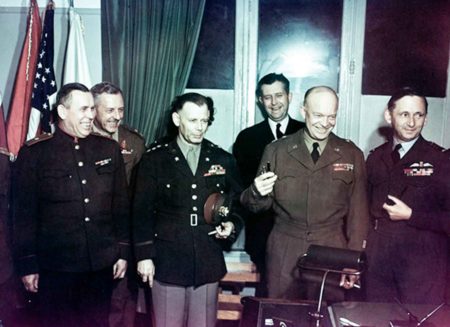
I guess winning a war ultimately boils down to the side that has the luckiest generals and makes the fewest mistakes.
Aunt Mollie
By 1996, Mollie was in her mid-eighties. She was the sister of Meryl Frank’s mother and the family’s self-proclaimed “Memorial Candle.” In other words, Aunt Mollie was responsible for the remembrance of her family and ensuring the family stories were carried on to the next generation.
Meryl was the youngest of four sisters and named after her maternal grandmother. As Meryl grew up, Aunt Mollie’s stories introduced her to various family members including Meryl’s grandparents who emigrated to the United States in 1905 passing through Castle Garden, the precursor to Ellis Island. Meryl’s grandmother, Meryl Kagan, lived in Vilna, Lithuania until she married Michel and became Meryl Boyarsky.
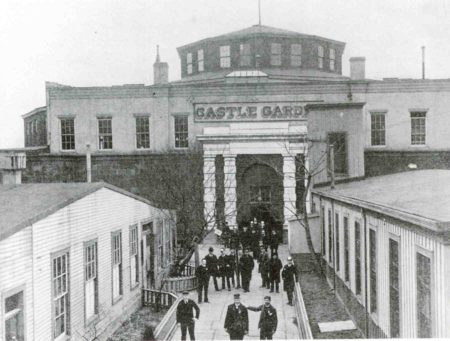
Aunt Mollie was a storyteller. Meryl learned about her family’s past through those stories as well as the family heirlooms and artifacts used by Mollie as props to spin the family lore. One period that Aunt Mollie did not shy away in her discussions with her niece was the Holocaust and the terrible toll it took on the Jews in Vilna and specifically, members of the family who stayed in Lithuania. She taught Meryl it was the responsibility of Jews to ensure the Holocaust was never repeated. The lessons Mollie was teaching Meryl had a purpose.
Vilna, Lithuania
Vilna (today it is called Vilnius, the historic capital and largest city of Lithuania) has a long and storied (albeit complicated) history dating back to the thirteenth century. Over the centuries, the city was overrun, occupied, divided, settled, and ruled by various countries including Germany, England, Russia, Prussia, the Habsburg Empire, and Poland. During World War I, German forces occupied Vilna and Lithuania. In early 1918, the country declared itself independent. However, at the end of 1918, Vilna fell to Soviet forces but two years later, Poland seized the city, and it became a separate state called the Republic of Central Lithuania. Poland annexed the capital and its surroundings in early 1922 and began a program of Lithuanian ethnocide which continued until the start of the second world war.
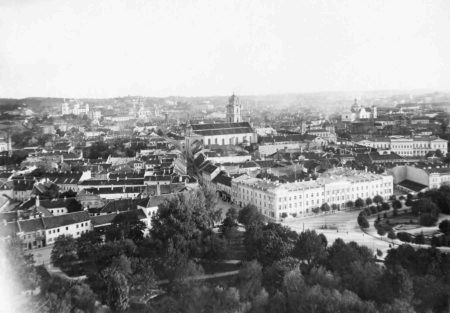
Hitler invited Lithuania to join forces with the Nazis to invade Poland. The government declined and adopted a neutrality policy. However, Hitler’s pact with the Soviets (i.e., Molotov-Ribbentrop Pact) called for the portioning of Lithuania and Poland into German and Soviet spheres. Ten days after Poland was invaded, the Soviets once again occupied Vilna and proceeded to ransack the city. In 1940, the Soviets annexed Lithuania and set up a Soviet government in Vilna. Almost thirty thousand residents were arrested and deported to the Siberian gulags.
Prior to World War II, about sixty thousand Jews lived in Vilna but only a few hundred survived the war. Ninety-five percent of Lithuania’s 265,000 Jews were murdered by the Nazis and local collaborators during the Holocaust. (Only six thousand Jews remained in the country after the war.)
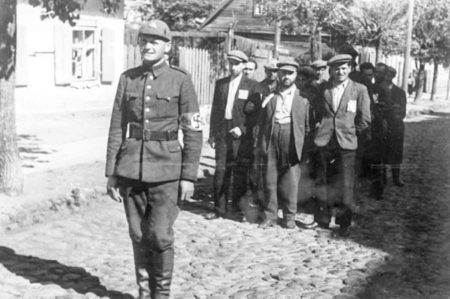
Mollie visited Vilna once in 1932. She met many of the family members, spouses, and friends whom Meryl would get to know during the years of Mollie’s family lessons and later from her decades of personal research. Mollie was welcomed by Tante Rivel into the family home on Ostrobramska next to the Trinity Gate. (Today, the street is known as Aušros Vartu.) During her stay in Vilna, Mollie attended a play in which Franya Winter performed. Franya was Meryl’s cousin and a very talented stage performer. It is said that if you were familiar with Yiddish theater at the time, you would have known Franya.
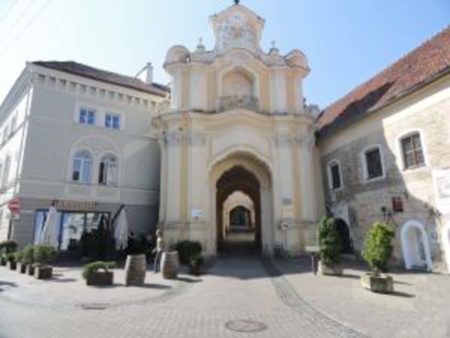
The New Memorial Candle
One day in mid-1996, Mollie summoned Meryl to her home in Bayonne, New Jersey. Mollie didn’t waste any time explaining that once she was gone, Meryl was expected to take on the responsibilities of keeping the memories of the family alive. In other words, Meryl would become the new “Memorial Candle.”
However, there was one responsibility more important than any other. Walking to a cabinet and opening the doors, Mollie pulled out a thin and frail book. She explained that Meryl was to become the custodian of the book and entrusted to keep it safe. The book was to be eventually passed on to one of Meryl’s children.
Aunt Mollie had one last instruction. She told Meryl, “Don’t read it.”
The Forbidden Book
The delicate book with brown lettering on the cover was about one hundred pages long. It was written in Yiddish, but one page was in English. The description explained the book was “about twenty-one Yiddish actors murdered by the Nazis in Vilna 1941-42.” There was a photograph and chapter dedicated to Franya. Her chapter was at the beginning of the book and Meryl later learned that the order of chapters had a certain significance.
The book was titled, Twenty-One and One. It was written by Shabtai Blecher, one of Franya’s fellow performers. As Meryl states in her book, “I couldn’t read the forbidden book. But I could learn about it.” So began Meryl Frank’s decades-long journey to piece together her family’s history and learn their fates. She learned the book began with the avant-garde Yiddish theater.
Eventually, Meryl had the book translated. Dr. Moshe Moskowitz, former chair of the Hebraic Studies Department at Rutgers University, called Meryl after he had completed the translation. He gave her a small glimpse into the life of her cousin confirming the popularity of the actress. He also told Meryl to honor her aunt’s wish and said, “Don’t read it.”
Franya Winter
Franya was one of the most popular actors of Yiddish theater during the interwar period. Aunt Mollie had explained that the avant-garde movement consisted of Yiddish-speaking writers, directors, and performers who broke social taboos and pushed the envelope to shock people. Mollie described Franya as a “prima donna.”
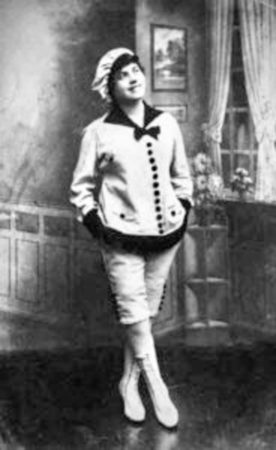
As Meryl dug deeper into her family’s past, she (like others) became infatuated with her cousin. During her professional life as a theatrical performer, it was Franya who interested peopled the most. Franya was very important and famous throughout eastern Europe. Through photographs, Meryl saw a “round face and coquettish expressions.” She could see the talent, sparkle, and imagined the audiences’ attraction while Franya was on stage would have been real.
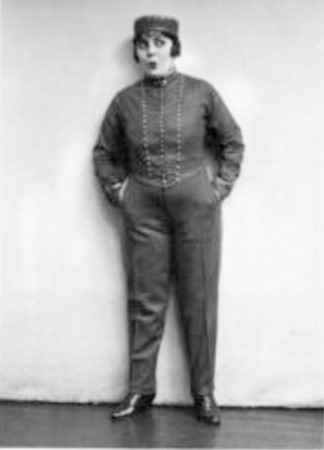
As Meryl began to fill in the gaps, she became increasingly focused on Franya. Raydel Rosenrot was born in Warsaw in 1896 to a poor Hasidic family. (After the end of the first world war, Rayed changed her name to Franya Winter.) It’s uncertain how much education Franya received. She spoke fluent Yiddish, Polish, Russian, and German so she must have had some education. As a young girl, Franya sang to non-Jewish audiences (including men which was taboo) to earn money and later moved onto Polish clubs and cabarets. Franya was fearless and her presence on the stage exploited her confidence. Her skills as an actor and singer took her to many European capitals where she performed and in 1922, Franya settled down in Vilna and joined the Jewish Folk Theater. Yiddish theater at that time was hugely popular in eastern Europe. Her performances included Hamlet, The Yiddish King Lear, and Tevy the Milkman (later to be adapted as Fiddler on the Roof).
German Occupation and the Ponary Massacres
Two days after invading the Soviet Union (i.e., Operation Barbarossa ⏤ 22 June 1941), the Germans marched into Vilna. The Nazi occupation of Lithuania and in particular, Vilna, was extremely brutal and lethal for its Jewish population.
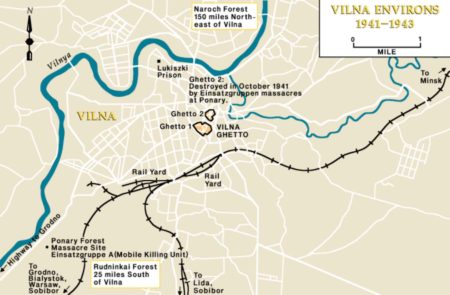
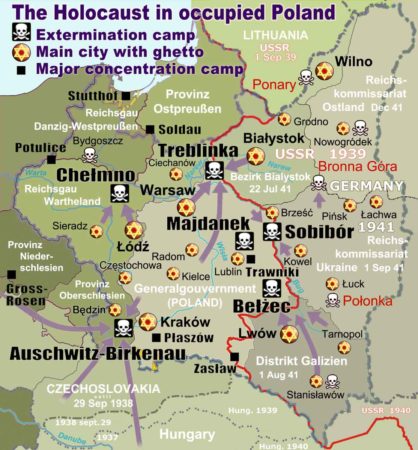
Two ghettos were created in the old town center in September 1941. Jews who were identified as unable to work were forced into the “Small Ghetto” (no. 2) and ultimately murdered by the Nazi Einsatzgruppen in October 1941. The “Large Ghetto” (no. 1) was home to Jews who were issued work permits and used as forced labor in local factories or construction projects. The Vilna ghetto was well known for its theatrical productions and The Ghetto Theater had a calming effect on citizens of the ghetto. Franya and her family moved into the ghetto, and she continued her performances.
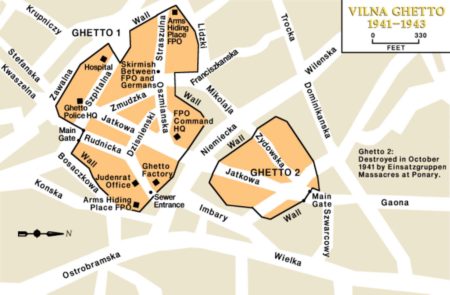
The ghetto had a significant resistance movement. The United Partisan Organization (FPO) was formed in 1942 and created hiding places for weapons in anticipation of an uprising. By early September 1943, the Nazis entered the ghetto to begin deportations. However, the Jewish council agreed to cooperate with the deportations and members of the FPO escaped from the ghetto and fled into the surrounding Rudniki and Naroch forests.
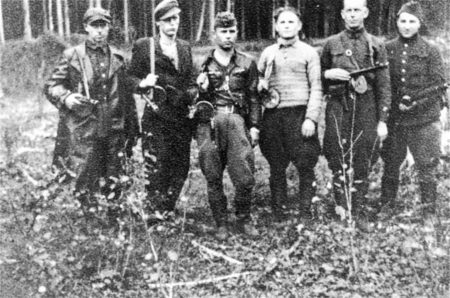
Before the Nazis established their extermination camps for the wholesale murder of Jews, they used Einsatzgruppen detachments sent into the eastern occupied countries to liquidate Jews and others deemed as “undesirables.” These Einsatzgruppen were mobile killing units and in September 1941 along with Lithuanian collaborators, began to round up Vilna’s Jewish citizens and imprison them in Lukiškės Prison. From there, the prisoners were taken to Panerikai, or Ponary where ten thousand prisoners were murdered. The two ghettos were established immediately afterward.

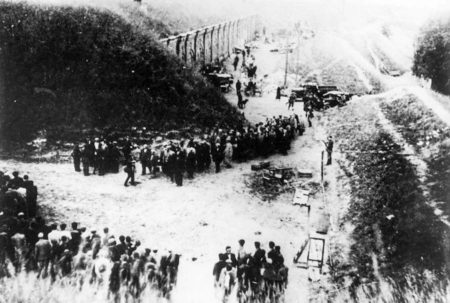
Between the establishment of the ghettos (1941) and the decision in 1943 to liquidate the remaining ghetto, the Nazis performed random Aktionen where they deported, executed, or “relocated” Jews. By January 1942, about twenty thousand Jews remained in the large ghetto. In late September 1943, the liquidation of the ghetto began in the six Ponary murder pits located in a nearby forest.
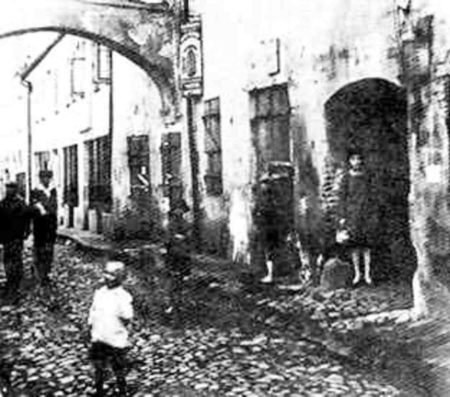
The pits had been dug in anticipation of the construction of an oil storage facility. The Nazis’ victims (primarily Jews, Poles, and Russians) were taken to the forest, hoods placed over their heads, stripped, and marched down a ramp to the bottom of the pit where they were shot. Based on survivors’ accounts, the men were shot first while their families watched. The executioners waited until the end of the day to kill the women and children. It was the Ypatingasis būrys, or Lithuanian killing squads that performed most of the actual killing. (A strong antisemitic movement took hold in Lithuania during the late 1920s and it wasn’t difficult to recruit Nazi collaborators.) It is estimated that about 100,000 people were murdered in these pits. Seventy thousand Jews along with twenty thousand Poles and eight thousand Soviet POWs were shot and killed in Ponary. The Holocaust Encyclopedia estimates that two-thirds of the Jews murdered occurred before the end of 1941.
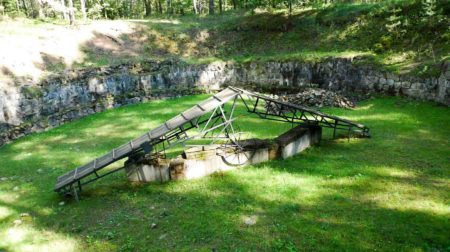
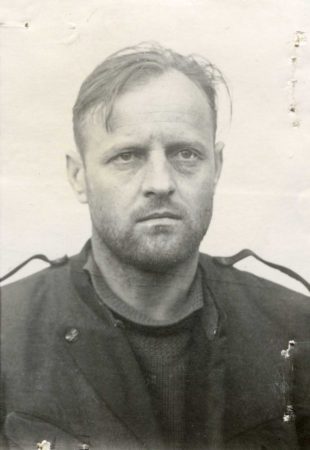
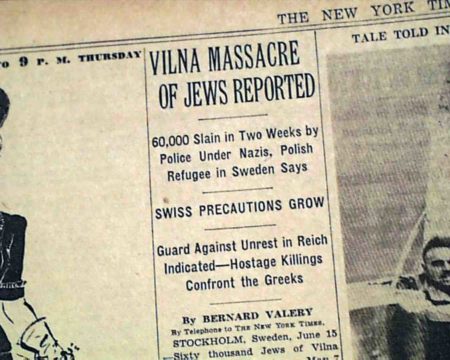
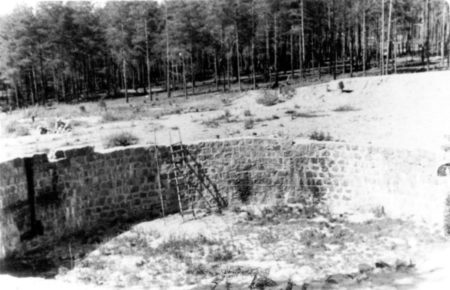
Spoiler Alert
If you intend to read Meryl Frank’s book, please do not read this section.
Meryl finally realized that she would have to break her promise to Aunt Mollie. After years of research including travels to Vilnius (Vilna), interviewing family members, first-hand witnesses, and Yiddish theater experts, thousands of hours in research libraries, visits to Yad Vashem and other Holocaust memorial museums (e.g., Mémorial de la Shoah), and discussions with Holocaust scholars, Meryl concluded she already knew the worst and what was likely Franya’s fate. It was also the end of her journey, and it seemed right that the last step was to read the book and learn the circumstances surrounding Franya’s death.
When Meryl was in high school, Aunt Mollie had divulged that Franya was killed outside a concentration camp. She had been identified by the Nazis as a person who could cause trouble. Meryl always wondered why read the forbidden book if this was the great mystery? As Meryl pursued her journey and learned more about the fates of her Vilna relatives, she began to believe Franya had met her end like everyone else. But there was always the nagging suspicion that perhaps an ugly fact about Franya was contained in the little book and Mollie was trying to protect Meryl from finding out.
Before Meryl read the forbidden book, she learned the chapters were arranged based on the chronological dates of deaths of the twenty-one performers. Franya’s chapter was third and as such, she was the third of the group to die. Meryl’s first clue about Franya’s fate came from her friend, Aurore, who worked at the Mémorial de la Shoah in Paris. Aurore had read the book and told Meryl that her cousin did not die in Vilna or in the Ponary pits. Franya actually perished in Ashmyany, Belarus, an area known for Jewish police (led by Felix Dessler) who cooperated with the Nazis in determining who would be deported from the ghetto and executed. At first, widows and children were the principal targets. The victims, totaling 406, were taken outside town to a freshly dug pit and shot by the Lithuanian militia. While it is likely Franya was in this group, Meryl imagined that perhaps Franya was forced to collaborate with the Nazis, and this is the terrible fact that Mollie was trying to hide from her. Maybe Mollie was trying to spare Meryl the details of the horrible atrocities committed by the death squads and ultimately, Franya’s murder.
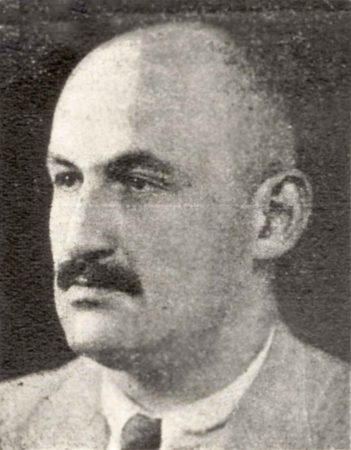
Meryl opened the book while acknowledging her curiosity about the fate of her cousin had finally superseded her desire to remain true to her aunt’s wish. On the evening of 1 October 1941, the roundup in Vilna began. The Jewish police ordered people with work permits to go to the main gate and get their permits stamped. The ghetto inhabitants were told by the police they’d be safe. Franya’s husband, Isaak, and Tante Rivel along with many others followed those orders. Franya did not have a job, so she remained behind in hiding. Thousands were arrested and held in Lukiškės Prison. Except for two hundred, none of these people were ever seen again. Known as the “Yom Kippur Aktion,” the Jews of Vilna immediately knew that work permits would not save their lives and the Jewish police could not be trusted.
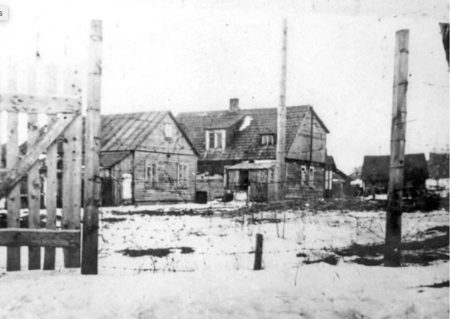
According to the book, Franya moved around quite frequently after the Yom Kippur Aktion. Without a work permit, she was advised to leave the ghetto. Franya found a way out and was assisted by non-Jews who demanded payment in return. When the money and jewels ran out, Franya was once again on her own. She determined Ashmyany was safer and by the time she arrived, only 1,950 Jews remained in the ghetto. Franya was wrong about Ashmyany and it became clear she couldn’t stay there. So, off she went headed back to Vilna. However, it was only a few miles from Ashmyany when the Nazi paramilitary police arrested her and the men she was traveling with. Taken to the local Jewish cemetery, the men were given shovels and told to dig their graves. At one point, the rebellious and defiant Franya bit one of the SS men.
Rather than shooting Franya, the order was given to bury her alive.
Next Blog: “Mulberry Harbor and the Delta Works”
Correspondence and Commentary Policy
We welcome everyone to contact us either directly or through the individual blogs. Sandy and I review every piece of correspondence before it is approved to be published on the blog site. Our policy is to accept and publish comments that do not project hate, political, religious stances, or an attempt to solicit business (yeah, believe it or not, we do get that kind of stuff). Like many bloggers, we receive quite a bit of what is considered “Spam.” Those e-mails are immediately rejected without discussion.
Our blogs are written to inform our readers about history. We want to ensure discussions are kept within the boundary of historical facts and context without personal bias or prejudice.
We average about one e-mail every two days from our readers. We appreciate all communication because in many cases, it has led to friendships around the world.
★ Read and Learn More About Today’s Topic ★
Frank, Meryl. Unearthed: A Lost Actress, a Forbidden Book, and a Search for Life in the Shadow of the Holocaust. New York: Hachette Books, 2023.
Kruk, Herman. Translated by Barbara Harshav. The Last Days of the Jerusalem of Lithuania: Chronicles from the Vilna Ghetto and the Camps, 1939-1944. New Haven: Yale University Press, 2002.
Roth, Michael S. ‘Unearthed’ Review: A Holocaust Story Kept Secret. Wall Street Journal, 17 April 2023. Click here to read the article.
Sutzkever, Abraham. Edited and translated by Justin D. Cammy. From the Vilna Ghetto to Nuremberg: Memoir and Testimony. Montreal: McGill-Queen’s University Press, 2021.
Disclaimer:
There may be a chance that after we publish this particular blog, the video links associated with the blog are no longer accessible. We have no control over this. Many times, whoever posts the video has done so without the consent of the video’s owner. In some cases, it is likely that the content is deemed unsuitable by YouTube. We apologize if you have tried to access the link and you don’t get the expected results. Same goes for internet links.
What’s New With Sandy and Stew?
Sandy and I recently returned from our river cruise on the Elbe River. We began our fourteen-day journey in Prague and ended it in Berlin. These are two cities neither of us had visited. In between were five days on the river. Most of our time was spent in territories occupied by the former Soviet Union. I enjoy traveling to former Soviet satellite countries because I always walk away with new ideas, sense of history, and increased knowledge. One of our best trips was the 2008 cruise on the Danube between Bucharest and Budapest where we visited five countries formerly under the thumb of the Soviets.
However, the high point on this trip was visiting Berlin. One of our goals was to begin the research for our future book, Where Did They Put the Führerbunker? A Walking Tour of Nazi Berlin 1933-1945. We visited KZ Sachsenhausen (thirty kilometers outside Berlin), one of the three remaining flak towers, and Grunewald rail station where Gleis 17, or Platform 17 is located as a memorial to Berlin’s deported Jews. Another mini journey was to Wannsee, southeast of Berlin. We toured the house where on 20 January 1942, fifteen senior Nazi leaders met to finalize the plan to exterminate European Jews. It was actually a meeting to present the “Final Solution” plan and obtain agreement to coordinate efforts.

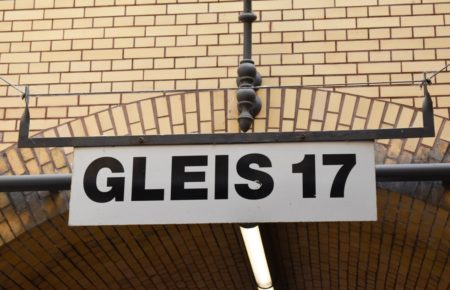

We also had a full day in Berlin with a private guide. Ryan was excellent and his knowledge was broad and deep on many subjects. The sites we asked to see are the ones a first-time visitor always wants to see. Now that we have that under our belt, I told Ryan we’d be back with a list of much lesser-known sites (click here to read the blog, Salon Kitty). If you go to Berlin and need a private guide, please let me know and I will introduce you to Ryan via Berlin Private Tours.
Thank you to all of you who subscribe to our bi-weekly blogs. It seems there isn’t a day that goes by where we don’t increase our readership. Please let your history buff friends and family members know about our blog site and blogs.
Someone Is Commenting On Our Blogs
As always, I’d like to thank some of you for contacting us regarding the blogs. So, to four of you, thanks: Marianne G. (Audrey Hepburn & Queen Wilhelmina), Glen C. (Camp King), Greg S. (Powerful Images), and Kim F. (Ciano’s Diaries).
If there is a topic you’d like to see a blog written about, please don’t hesitate to contact me. I love hearing from you so keep those comments coming.
Do you enjoy reading? Do you have a hard time finding the right book in the genre you enjoy? Well, Ben at Shepherd.com has come up with an amazing way to find that book.
Shepherd highlights an author (like me) and one of their books (in our case, it is Where Did They Put the Gestapo Headquarters?). The author is required to review five books in the same genre. So, if a reader is interested say in cooking, they can drill down and find specific books about cooking that have been reviewed by authors in that category. Very simple.
If you like to read, I highly recommend you visit Shepherd.com. If you do, please let me know what you think and I will forward Ben any suggestions or comments you might have.
Click here to visit Shepherd’s website.
Click the books to visit Stew’s bookshelf.
Share This:
Follow Stew:
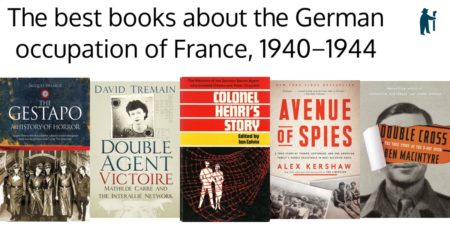
Find Stew’s books on Amazon and Apple Books.
Please note that we do not and will not take compensation from individuals or companies mentioned or promoted in the blogs.
 Walks Through History
Walks Through History
Copyright © 2023 Stew Ross


